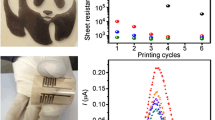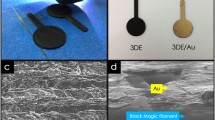Abstract
Printed graphene electrodes have been demonstrated as a versatile platform for electrochemical sensing, with numerous examples of rapid sensor prototyping using laboratory-scale printing techniques such as inkjet and aerosol jet printing. To leverage these materials in a scalable production framework, higher-throughput printing methods are required with complementary advances in ink formulation. Flexography printing couples the attractive benefits of liquid-phase graphene printing with large-scale manufacturing. Here, we investigate graphene flexography for the fabrication of electrodes by analyzing the impacts of ink and process parameters on print quality and electrical properties. Characterization of the printed patterns reveals anisotropic structure due to striations along the print direction, which is related to viscous fingering of the ink. However, high-resolution imaging reveals a dense graphene network even in regions of sparse coverage, contributing to robust electrical properties even for the thinnest films (< 100 nm). Moreover, the mechanical and environmental sensitivity of the printed electrodes is characterized, with particular focus on atmospheric response and thermal hysteresis. Overall, this work reveals the conditions under which graphene inks can be employed for high-speed flexographic printing, which will facilitate the development of graphene-based sensors and related devices.
Graphical abstract








Similar content being viewed by others
Availability of data and material
The datasets generated during and/or analyzed during the current study are available from the corresponding author on reasonable request.
References
Sui X, Downing JR, Hersam MC, Chen J (2021) Additive manufacturing and applications of nanomaterial-based sensors. Mater Today 48:135–154. https://doi.org/10.1016/j.mattod.2021.02.001
Geim AK, Novoselov KS (2007) The rise of graphene. Nat Mater 6:183–191
Kim H, Ahn JH (2017) Graphene for flexible and wearable device applications. Carbon N Y 120:244–257. https://doi.org/10.1016/j.carbon.2017.05.041
Wisitsoraat A, Mensing JP, Karuwan C et al (2017) Printed organo-functionalized graphene for biosensing applications. Biosens Bioelectron 87:7–17. https://doi.org/10.1016/j.bios.2016.07.116
Xu L, Wang H, Wu Y et al (2021) A one-step approach to green and scalable production of graphene inks for printed flexible film heaters. Mater Chem Front 5:1895–1905. https://doi.org/10.1039/d0qm00803f
Chang Q, Li L, Sai L et al (2018) Water-soluble hybrid graphene ink for gravure-printed planar supercapacitors. Adv Electron Mater 4:1–10. https://doi.org/10.1002/aelm.201800059
Meng FL, Guo Z, Huang XJ (2015) Graphene-based hybrids for chemiresistive gas sensors. Trends Anal Chem 68:37–47. https://doi.org/10.1016/j.trac.2015.02.008
Zhang Q, An C, Fan S et al (2018) Flexible gas sensor based on graphene/ethyl cellulose nanocomposite with ultra-low strain response for volatile organic compounds rapid detection. Nanotechnology 29:285501. https://doi.org/10.1088/1361-6528/aabf2f
Le T, Lakafosis V, Lin Z, et al (2012) Inkjet-printed graphene-based wireless gas sensor modules. IEEE 62nd Electron Components Technol Conf 1003–1008. https://doi.org/10.1109/ECTC.2012.6248958
Sethi J, Van Bulck M, Suhail A et al (2020) A label-free biosensor based on graphene and reduced graphene oxide dual-layer for electrochemical determination of beta-amyloid biomarkers. Microchim Acta 187:288. https://doi.org/10.1007/s00604-020-04267-x
Parate K, Rangnekar SV, Jing D et al (2020) Aerosol-jet-printed graphene immunosensor for label-free cytokine monitoring in serum. ACS Appl Mater Interfaces 12:8592–8603. https://doi.org/10.1021/acsami.9b22183
Sanati A, Jalali M, Raeissi K et al (2019) A review on recent advancements in electrochemical biosensing using carbonaceous nanomaterials. Microchim Acta 186:773. https://doi.org/10.1007/s00604-019-3854-2
Gomez FJV, Martín A, Silva MF, Escarpa A (2015) Screen-printed electrodes modified with carbon nanotubes or graphene for simultaneous determination of melatonin and serotonin. Microchim Acta 182:1925–1931. https://doi.org/10.1007/s00604-015-1520-x
Xu J, Wang Y, Hu S (2017) Nanocomposites of graphene and graphene oxides: Synthesis, molecular functionalization and application in electrochemical sensors and biosensors. A reiew. Microchim Acta 184:1–44. https://doi.org/10.1007/s00604-016-2007-0
Parate K, Pola CC, Rangnekar SV et al (2020) Aerosol-jet-printed graphene electrochemical histamine sensors for food safety monitoring. 2D Mater 7:034002. https://doi.org/10.1088/2053-1583/ab8919
Secor EB, Prabhumirashi PL, Puntambekar K et al (2013) Inkjet printing of high conductivity, flexible graphene patterns. J Phys Chem Lett 4:1347–1351. https://doi.org/10.1021/jz400644c
Dongmo LM, Guenang LS, Jiokeng SLZ et al (2021) A new sensor based on an amino-montmorillonite-modified inkjet-printed graphene electrode for the voltammetric determination of gentisic acid. Microchim Acta 188:36. https://doi.org/10.1007/s00604-020-04651-7
Khan S, Lorenzelli L, Dahiya RS (2015) Technologies for printing sensors and electronics over large flexible substrates: A review. IEEE Sens J 15:3164–3185. https://doi.org/10.1109/JSEN.2014.2375203
Secor EB, Lim S, Zhang H et al (2014) Gravure printing of graphene for large-area flexible electronics. Adv Mater 26:4533–4538. https://doi.org/10.1002/adma.201401052
Bonaccorso F, Bartolotta A, Coleman JN, Backes C (2016) 2D-crystal-based functional inks. Adv Mater 28:6136–6166. https://doi.org/10.1002/adma.201506410
Maddipatla D, Narakathu BB, Atashbar M (2020) Recent progress in manufacturing techniques of printed and flexible sensors: a review. Biosensors 10:199. https://doi.org/10.3390/bios10120199
Brumm P, Sauer H, Dörsam E (2019) Scaling behavior of pattern formation in the flexographic ink splitting process. Colloids and Interfaces 3:37. https://doi.org/10.3390/colloids3010037
Benson J, Fung CM, Lloyd JS et al (2015) Direct patterning of gold nanoparticles using flexographic printing for biosensing applications. Nanoscale Res Lett 10:1–8. https://doi.org/10.1186/s11671-015-0835-1
Morgan ML, Holder A, Curtis DJ, Deganello D (2018) Formulation, characterisation and flexographic printing of novel Boger fluids to assess the effects of ink elasticity on print uniformity. Rheol Acta 57:105–112. https://doi.org/10.1007/s00397-017-1061-9
Kempa H, Hambsch M, Reuter K et al (2011) Complementary ring oscillator exclusively prepared by means of gravure and flexographic printing. IEEE Trans Electron Devices 58:2765–2769. https://doi.org/10.1109/TED.2011.2153856
Chen S, Brahma S, Mackay J et al (2020) The role of smart packaging system in food supply chain. J Food Sci 85:517–525. https://doi.org/10.1111/1750-3841.15046
Morgan ML, Curtis DJ, Deganello D (2019) Control of morphological and electrical properties of flexographic printed electronics through tailored ink rheology. Org Electron 73:212–218. https://doi.org/10.1016/j.orgel.2019.05.027
Tran TS, Dutta NK, Choudhury NR (2018) Graphene inks for printed flexible electronics: graphene dispersions, ink formulations, printing techniques and applications. Adv Colloid Interface Sci 261:41–61. https://doi.org/10.1016/j.cis.2018.09.003
Watson TM, Deganello D, Gethin DT (2014) Flexographic printing of graphene nanoplatelet ink to replace platinum as counter electrode catalyst in flexible dye sensitised solar cell. Energy Mater Mater Sci Eng Energy Syst 9:86–90. https://doi.org/10.1179/1433075X14Y.0000000203
Liang YT, Hersam MC (2010) Highly concentrated graphene solutions via polymer enhanced solvent exfoliation and iterative solvent exchange. J Am Chem Soc 132:17661–17663. https://doi.org/10.1021/ja107661g
Kumar S (2015) Liquid transfer in printing processes: liquid bridges with moving contact lines. Annu Rev Fluid Mech 47:67–94. https://doi.org/10.1146/annurev-fluid-010814-014620
Joyce M, Avuthu SGR, Emamian S et al (2014) Contribution of flexo process variables to fine line Ag electrode performance. Int J Eng Res Te 3:1645–1656
Yamuna A, Sundaresan P, Chen SM (2019) Ethylcellulose assisted exfoliation of graphite by the ultrasound emulsification: an application in electrochemical acebutolol sensor. Ultrason Sonochem 59:104720. https://doi.org/10.1016/j.ultsonch.2019.104720
Kim DS, Jeong JM, Park HJ et al (2021) Highly concentrated, conductive, defect-free graphene ink for screen-printed sensor application. Nano-Micro Lett 13:87. https://doi.org/10.1007/s40820-021-00617-3
Kirchner EM, Hirsch T (2020) Recent developments in carbon-based two-dimensional materials: synthesis and modification aspects for electrochemical sensors. Microchim Acta 187:441. https://doi.org/10.1007/s00604-020-04415-3
Ryu S, Liu L, Berciaud S et al (2010) Atmospheric oxygen binding and hole doping in deformed graphene on a SiO2 substrate. Nano Lett 10:4944–4951. https://doi.org/10.1021/nl1029607
Phillips C, Al-Ahmadi A, Potts SJ et al (2017) The effect of graphite and carbon black ratios on conductive ink performance. J Mater Sci 52:9520–9530. https://doi.org/10.1007/s10853-017-1114-6
Karagiannidis PG, Hodge SA, Lombardi L et al (2017) Microfluidization of graphite and formulation of graphene-based conductive inks. ACS Nano 11:2742–2755. https://doi.org/10.1021/acsnano.6b07735
Hondred JA, Stromberg LR, Mosher CL et al (2017) High-resolution graphene films for electrochemical sensing via inkjet maskless lithography. ACS Nano 11:9836–9845. https://doi.org/10.1021/acsnano.7b03554
Acknowledgements
This work was supported by the Harry S. Truman Fellowship through the Laboratory Directed Research and Development program at Sandia National Laboratories. This work was performed, in part, at the Center for Integrated Nanotechnologies, an Office of Science User Facility operated for the U.S. Department of Energy (DOE) Office of Science. Sandia National Laboratories is a multi-program laboratory managed and operated by National Technology and Engineering Solutions of Sandia, LLC, a wholly owned subsidiary of Honeywell International, Inc., for the US Department of Energy’s National Nuclear Security Administration under contract DE-NA-0003525. This paper describes objective technical results and analysis. Any subjective views or opinions that might be expressed in the paper do not necessarily represent the views of the US Department of Energy or the United States Government. The authors would like to acknowledge support from Iowa State University, the National Science Foundation Scalable Nanomanufacturing Program (NSF CMMI-1727846 and NSF CMMI-2039268), and the National Science Foundation Future Manufacturing Program (NSF CMMI-2037026). Rheometry and thermogravimetric analysis were performed in the Materials Characterization and Imaging (MatCI) Facility at Northwestern University, which receives support from the National Science Foundation Materials Research Science and Engineering Center Program (NSF DMR-1720139).
Funding
Sandia National Laboratories, Laboratory Directed Research and Development Program; DOE Center for Integrated Nanotechnologies; National Science Foundation Scalable Nanomanufacturing Program; National Science Foundation Future Manufacturing Program.
Author information
Authors and Affiliations
Contributions
Ethan B. Secor contributed to conceptualization; Ethan B. Secor, Julia R. Downing, Rebecca R. Tafoya, Michael Gallegos, Eric N. Coker, and Livio Gamba provided methodology; Julia R. Downing, Rebecca R. Tafoya, Livio Gamba, and Ethan B. Secor performed formal analysis and investigation; Rebecca R. Tafoya and Ethan B. Secor performed writing—original draft preparation; Mark C. Hersam, Michael Gallegos, Bryan Kaehr, Julia R. Downing, and Eric N. Coker performed writing—review and editing; Mark C. Hersam, Ethan B. Secor, and Bryan Kaehr contributed to funding acquisition; Mark C. Hersam and Bryan Kaehr provided resources; Mark C. Hersam and Ethan B. Secor done supervision.
Corresponding author
Ethics declarations
Conflicts of interest
The authors declare no competing interest.
Additional information
Publisher's note
Springer Nature remains neutral with regard to jurisdictional claims in published maps and institutional affiliations.
Supplementary Information
Below is the link to the electronic supplementary material.
Rights and permissions
About this article
Cite this article
Tafoya, R.R., Gallegos, M.A., Downing, J.R. et al. Morphology and electrical properties of high-speed flexography-printed graphene. Microchim Acta 189, 123 (2022). https://doi.org/10.1007/s00604-022-05232-6
Received:
Accepted:
Published:
DOI: https://doi.org/10.1007/s00604-022-05232-6




